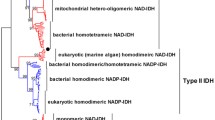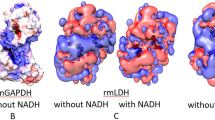Abstract
NAD+ and NADP+, chemically similar and with almost identical standard oxidation–reduction potentials, nevertheless have distinct roles, NAD+ serving catabolism and ATP generation whereas NADPH is the biosynthetic reductant. Separating these roles requires strict specificity for one or the other coenzyme for most dehydrogenases. In many organisms this holds also for glutamate dehydrogenases (GDH), NAD+-dependent for glutamate oxidation, NADP+-dependent for fixing ammonia. In higher animals, however, GDH has dual specificity. It has been suggested that GDH in mitochondria reacts only with NADP(H), the NAD+ reaction being an in vitro artefact. However, contrary evidence suggests mitochondrial GDH not only reacts with NAD+ but maintains equilibrium using the same pool as accessed by β-hydroxybutyrate dehydrogenase. Another complication is the presence of an energy-linked dehydrogenase driving NADP+ reduction by NADH, maintaining the coenzyme pools at different oxidation–reduction potentials. Its coexistence with GDH makes possible a futile cycle, control of which is not yet properly explained. Structural studies show NAD+-dependent, NADP+-dependent and dual-specificity GDHs are closely related and a few site-directed mutations can reverse specificity. Specificity for NAD+ or for NADP+ has probably emerged repeatedly during evolution, using different structural solutions on different occasions. In various GDHs the P7 position in the coenzyme-binding domain plays a key role. However, whereas in other dehydrogenases an acidic P7 residue usually hydrogen bonds to the 2′- and 3′-hydroxyls, dictating NAD+ specificity, among GDHs, depending on detailed conformation of surrounding residues, an acidic P7 may permit binding of NAD+ only, NADP+ only, or in higher animals both.
Similar content being viewed by others
References
Austen BM, Haberland ME, Nyc JF, Smith EL (1977) Nicotinamide adenine dinucleotide-specific glutamate dehydrogenase of Neurospora. IV. The COOH-terminal 669 residues of the peptide chain; comparison with other glutamate dehydrogenases. J Biol Chem 252:8142–8149
Baker PJ, Britton KL, Engel PC, Farrants GW, Lilley KS, Rice DW, Stillman TJ (1992) Subunit assembly and active site location in the structure of glutamate dehydrogenase. Proteins 12:75–86
Baker PJ, Britton KL, Rice DW, Rob A, Stillman TJ (1992) Structural consequences of sequence patterns in the fingerprint region of the nucleotide binding fold: implications for nucleotide specificity. J Mol Biol 228:662–671
Benachenhou N, Baldacci G (1991) The gene for a halophilic glutamate dehydrogenase: sequence, transcription analysis and phylogenetic implications. Mol Gen Genet 230:345–352
Bhuiya MW, Sakuraba H, Ohshima T, Imagawa T, Katunuma N, Tsuge H (2005) The first crystal structure of hyperthermostable NAD-dependent glutamate dehydrogenase from Pyrobaculum islandicum. J Mol Biol 345:325–337
Bocanegra JA, Scrutton NS, Perham RN (1993) Creation of an NADP-dependent pyruvate dehydrogenase multienzyme complex by protein engineering. Biochemistry 32:2737–2740
Brändén C-I, Jörnvall H, Eklund H, Furugren B (1975) Alcohol dehydrogenase. In: Boyer PD (ed) The enzymes, vol 11. Academic Press, New York, pp 103–190
Britton KL, Baker PJ, Rice DW, Stillman TJ (1992) Structural relationship between the hexameric and tetrameric family of glutamate dehydrogenases. Eur J Biochem 209:851–859
Capone M, Scanlon D, Griffin J, Engel PC (2011) Re-engineering the discrimination between the oxidised coenzymes NAD+ and NADP+ in a glutamate dehydrogenase and a reappraisal of the specificity of the wild-type enzyme. FEBS J 278:2460–2468
Carrigan JB, Engel PC (2007) Probing the determinants of coenzyme specificity in Peptostreptococcus asaccharolyticus glutamate dehydrogenase by site-directed mutagenesis. FEBS J 274:5167–5174
Danielson L, Ernster L (1963) Demonstration of a mitochondrial energy-dependent pyridine nucleotide transhydrogenase reaction. Biochem Biophys Res Commun 10:91–96
Danielson L, Ernster L (1963) Energy-dependent reduction of triphosphopyridine nucleotide by reduced diphosphopyridine nucleotide, coupled to the energy-transfer system of the respiratory chain. Biochem Z 338:188–205
Engel PC, Dalziel K (1967) Equilibrium constants of the glutamate dehydrogenase systems. Biochem J 105:691–695
Glock GE, McLean P (1956) The intracellular distribution of pyridine nucleotides in rat liver. Exp Cell Res 11:234–236
Griffin J, Engel PC (2011) Site-directed mutagenesis of the coenzyme binding site of clostridial glutamate dehydrogenase designed to overcome the preference for NADH over NADPH. Enzyme Research volume, p 9, Article ID 595793. doi:10.4061/2011/595793
Hanukoglu I, Gutfinger T (1989) cDNA sequence of adrenodoxin reductase. Identification of NADP binding sites in oxidoreductases. Eur J Biochem 180:479–484
Hayden BM, Bonete M-J, Brown PE, Moir AJG, Engel PC (2002) Glutamate dehydrogenase of Halobacterium salinarum: evidence that the gene sequence currently assigned to the NADP+-dependent enzyme is in fact that of the NAD+-dependent glutamate dehydrogenase. FEMS Microbiol Lett 211:37–41
Holbrook JJ, Liljas A, Steindel SJ, Rossmann MG (1975) Lactate dehydrogenase. In: Boyer PD (ed) The enzymes, vol 11. Academic Press, New York, pp 191–292
Klingenberg M, Pette D (1962) Proportions of mitochondrial enzymes and pyridine nucleotides. Biochem Biophys Res Commun 7:430–432
Klingenberg M, Slenczka W (1959) Pyridine nucleotide in liver mitochondria. An analysis of their redox relationships. Biochem Z 331:486–517
Lilley KS, Baker PJ, Britton KL, Stillman TJ, Brown PE, Moir AJG, Engel PC, Rice DW, Bell JE, Bell E (1991) The partial amino acid sequence of the NAD+-dependent glutamate dehydrogenase of C. symbiosum. Implications for the evolution and structural basis of coenzyme specificity. Biochim Biophys Acta 1080:191–197
McCarthy AD, Walker JM, Tipton KF (1980) Purification of glutamate dehydrogenase from ox brain and liver. Evidence that commercially available preparations of the enzyme from ox liver have suffered proteolytic cleavage. Biochem J 191:605–611
Oliveira T, Panjikar S, Carrigan J, Hamza M, Engel PC, Khan AR (2012) Crystal structure of NAD-dependent Peptoniphilus asaccharolyticus glutamate dehydrogenase in the Apo form reveals determinants of cofactor specificity. J Struct Biol 177:543–552
Peterson PE, Smith TJ (1999) The structure of bovine glutamate dehydrogenase provides insights into the mechanism of allostery. Struct Fold Des 7:769–782
Plaitakis A, Metaxari M, Shashidharan P (2000) Nerve tissue-specific (GLUD2) and housekeeping (GLUD1) human glutamate dehydrogenases are regulated by distinct allosteric mechanisms. Implications for biologic function. J Neurochem 75:1862–1869
Scrutton NS, Berry A, Perham RN (1990) Redesign of the coenzyme specificity of a dehydrogenase by protein engineering. Nature 343:38–43
Sharkey MA, Engel PC (2009) Modular coenzyme specificity and cooperativity in a domain-swopped chimaera of glutamate dehydrogenase. Proteins 77:268–278
Sharkey MA, Gori A, Capone M, Engel PC (2012) Reversal of the extreme coenzyme selectivity of Clostridium symbiosum glutamate dehydrogenase. FEBS J 279:3003–3009
Sharkey MA, Oliveira T, Engel PC, Khan AR (2013) Structural basis for NADP+ specificity of glutamate dehydrogenase from Escherichia coli. FEBS J (accepted)
Shashidharan P, Michaelidis TM, Robakis NK, Kresovali A, Papamatheakis J, Plaitakis A (1994) Novel human glutamate dehydrogenase expressed in neural and testicular tissues and encoded by an X-linked intronless gene. J Biol Chem 269:16971–16976
Smith EL, Austen BM, Blumenthal KM, Nyc JF (1975) Glutamate dehydrogenases. In: Boyer PD (ed) The enzymes, vol 11. Academic Press, New York, pp 293–367
Smith TJ, Peterson PE, Schmidt T, Fang J, Stanley CA (2001) Structures of bovine glutamate dehydrogenase complexes elucidate the mechanism of purine regulation. J Mol Biol 307:707–720
Smith TJ, Schmidt T, Fang J, Wu J, Siuzdak G, Stanley CA (2002) The structure of apo human glutamate dehydrogenase details subunit communication and allostery. J Mol Biol 318:765–777
Snedecor B, Chu H, Chen E (1991) Selection, expression and nucleotide sequencing of the glutamate dehydrogenase gene of Peptostreptococcus asaccharolyticus. J Bact 173:6162–6167
Stillman TJ, Baker PJ, Britton KL, Rice DW (1993) Conformational flexibility in glutamate dehydrogenase: Role of water in substrate recognition and catalysis. J Mol Biol 234:1131–1139
Tager JM, Papa S (1965) On the nicotinamide nucleotide specificity of glutamate dehydrogenase in rat-liver mitochondria. Biochim Biophys Acta 99:570–572
Teller JK, Smith RJ, McPherson MJ, Engel PC, Guest JR (1992) The glutamate dehydrogenase gene of Clostridium symbiosum. Cloning of polymerase chain reaction, sequence analysis and over-expression in Escherichia coli. Eur J Biochem 206:151–159
Wierenga RK, Terpstra P, Hol WG (1986) Prediction of the occurrence of the ADP-binding βαβ-fold in proteins, using an amino acid sequence fingerprint. J Mol Biol 187:101–107
Williamson DH, Lund P, Krebs HA (1967) The redox state of free nicotinamide-adenine dinucleotide in the cytoplasm and mitochondria of rat liver. Biochem J 103:514–527
Yip KSP, Stillman TJ, Britton KL, Artymiuk PJ, Baker PJ, Sedelnikova S, Engel PC, Pasquo A, Chiaraluce R, Consalvi V, Scandurra R, Rice DW (1995) The structure of Pyrococcus furiosus glutamate dehydrogenase reveals a key role for ion-pair networks in maintaining enzyme stability at extreme temperatures. Structure 3:1147–1158
Acknowledgments
The author wishes to acknowledge the support of Enterprise Ireland and more recently Science Foundation Ireland over almost 20 years of research in Dublin. The importance of two collaborations with crystallographers has been immeasurably important. First of all the collaboration with Prof. David Rice’s group at Sheffield provided the first GDH structure and laid the foundations for much of our understanding of GDH and its other amino acid dehydrogenase cousins. Latterly the collaboration with Dr. Amir Khan and his group at Trinity College Dublin has provided a number of new structures and opened our eyes to the subtleties outlined in this paper. Above all I should acknowledge the hard work of members of my group over many years who made, purified and characterised the coenzyme specificity mutants—Michael Sharkey, Joanna Griffin, Marina Capone, David Scanlon, John Carrigan, Alessandro Gori.
Author information
Authors and Affiliations
Corresponding author
Rights and permissions
About this article
Cite this article
Engel, P.C. Glutamate Dehydrogenases: The Why and How of Coenzyme Specificity. Neurochem Res 39, 426–432 (2014). https://doi.org/10.1007/s11064-013-1089-x
Received:
Revised:
Accepted:
Published:
Issue Date:
DOI: https://doi.org/10.1007/s11064-013-1089-x




